The Urgel Cinema, Barcelona, Spain | Read more at in70mm.com The 70mm Newsletter |
| Written by: Ramon Lamarca Marques, England. Some pictures by: Grup Balañá and by Mr Gerard Muñoz Pleguezuelo | Date: 16.09.2011 |
 The Urgel Cinema, known by many of us in Catalan as l’Urgell,
is one of the few remaining 70mm cinema palaces left in the world. With
1.832 seats, it is likely to be the operating cinema with the highest number
of seats in Europe. The Odeon Leicester Square claims to be the largest
cinema in Europe, but it has 1683 seats. The Urgel Cinema, known by many of us in Catalan as l’Urgell,
is one of the few remaining 70mm cinema palaces left in the world. With
1.832 seats, it is likely to be the operating cinema with the highest number
of seats in Europe. The Odeon Leicester Square claims to be the largest
cinema in Europe, but it has 1683 seats.The cinema was opened by Mr Pedro Balañá Forts. His father had started the business of cinema exhibition in Barcelona and the business has continued in the family. The architect who designed the cinema was Manuel Francès and Antoni Bonamusa was responsible for the decoration. | More in 70mm reading: The Urgel Cinema - Gallery mainly 70mm releases, which illustrate this cinema’s history 3-strip in Barcelona, Spain 65/70mm Workshop Intro to Brunet conversation Rick Mitchell Interview
|
 The cinema was built in one of Barcelona’s interior patios in carrer Urgell
(Urgell street). You can see the roof of the cinema on this aerial picture
obtained from Google maps: The cinema was built in one of Barcelona’s interior patios in carrer Urgell
(Urgell street). You can see the roof of the cinema on this aerial picture
obtained from Google maps: | |
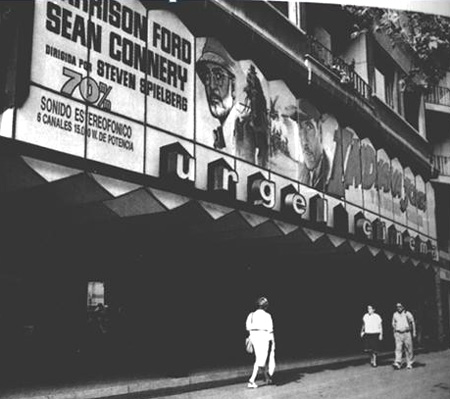 The
big marquee over the cinema entrance. The
big marquee over the cinema entrance.A big marquee presides over the cinema entrance. It used to have tailor-made designs for each film the cinema was showing but this recently disappeared and was replaced by just two posters of the film exhibited. It was impressive to see the designs for each film but I would imagine that since films last so little in exhibition nowadays it is not financially viable to make designs for just a few days. | |
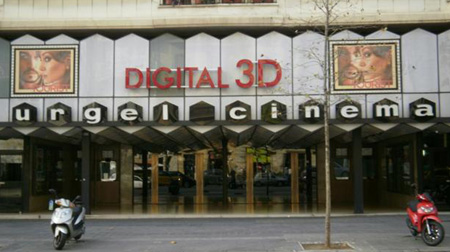 This picture shows the current marquee with Digital 3D taking prominence,
even if the film shown is not in 3-D. The film shown is displayed on two
rather small posters. This picture shows the current marquee with Digital 3D taking prominence,
even if the film shown is not in 3-D. The film shown is displayed on two
rather small posters.The box offices are under the big marquee at the same level as the main doors that lead to the cinema. The film posters have always been displayed by the ticket offices, on each side. Technical characteristics of the cinema have also been displayed alongside the film posters. | |
 The film posters you are seeing in this rather bad picture I took are from
The Thing and Indiana Jones and the temple of doom. They are fairly recent
and form part of a project called Phenomena that brings films from the 70s,
80s and 90s back on the big screen The film posters you are seeing in this rather bad picture I took are from
The Thing and Indiana Jones and the temple of doom. They are fairly recent
and form part of a project called Phenomena that brings films from the 70s,
80s and 90s back on the big screenAfter the main doors, wide stairs take you to the distribution hall where you can decide to continue going down and go to the stalls or go up and access the balcony. | |
 Main entrance doors from inside Main entrance doors from insideThe colour vermillion dominates the decoration of the huge cinema auditorium. The light is mainly indirect from behind the panels on the side walls and on the ceiling, which has decorative beams that hide the lights. | |
 Impressive image of the auditorium from the balcony with the curtains opened Impressive image of the auditorium from the balcony with the curtains openedAnother significant aspect of the cinema is that (in the stalls only) the armrests are individual for each seat, which means you do not have to share your armrest with your neighbour and there is good leg room between rows. | |
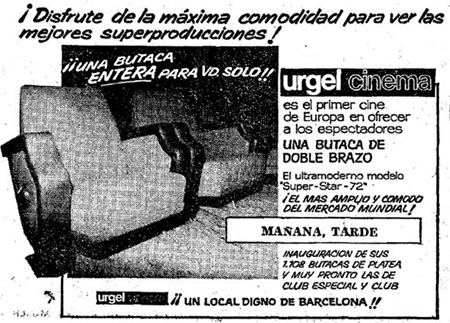 The double armrests were not an original feature of this cinema as this
advert demonstrates. The double armrests were not an original feature of this cinema as this
advert demonstrates.These seats were fitted on the 14th of February 1972. The advert says: Enjoy of the maxim comfort to see the best super-productions! A whole seat for you alone!! Urgel Cinema is the first cinema in Europe to offer its patrons a seat with a double armrest… It adds that this is only for the stalls but that very soon it will also be for the balcony but the seats with double armrest for the balcony never arrived and they have remained with a single armrest. | |
 View from the stalls with the double armrests can be clearly seen – the
double curtains system (white and red curtains) can also be seen View from the stalls with the double armrests can be clearly seen – the
double curtains system (white and red curtains) can also be seenI would have imagined that when the cinema opened on the 20th of September 1963 they would have installed a 70mm projection system, especially since 70mm had been used in some cinemas in Barcelona already for some years. However, this was not the case and the cinema was only equipped initially to show 35mm. The first film ever shown was Otto Preminger’s Carmen Jones. | |
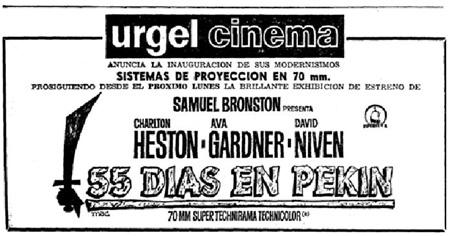 70mm arrived at the Urgel Cinema in April 1964 with the release of
"55 Days
in Peking". 70mm arrived at the Urgel Cinema in April 1964 with the release of
"55 Days
in Peking". I am told that the current Cinemeccanica Victoria 8 is the original one. I am sure that originally they had two since there were no platters then. However now in the projection booth there is the Vic 8 and one digital projector Christie CP-2000. | |
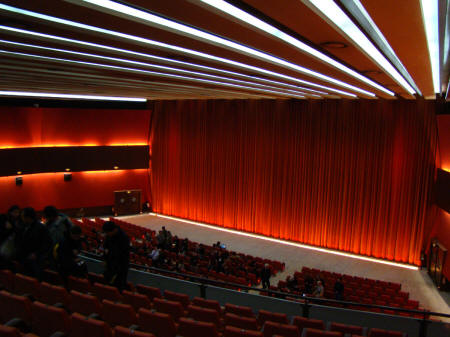 Another view from the balcony with the curtains closed Another view from the balcony with the curtains closedThe cinema has had five channels behind its screen since 70mm was first used there. It has had for a long time and still has a Dolby processor CP200 with noise reduction Dolby “A” and Dolby “SR” for 35mm and 70mm films. It also has Dolby Digital Surround Ex and DTS only for 35mm prints. The Dolby processor CP200, although discontinued now for many years is still regarded as a fantastic processor, great for 70mm magnetic sound. Let’s hope that the cinema brings back some 70mm analogue prints from the 80s to show it off properly. The amplifier system and speakers are JBL with a power of 15,000 watts RMS with five channels behind the screen, three surround channels and High Fidelity speakers for the LFE channel. There are currently no cinema sound systems that simultaneously use the five speaker channels behind the screen and the three surrounds. | |
 In December 1987 the cinema upgraded its sound installation for the
screenings of "The Last Emperor" in 70mm. The ad on the newspaper described
the technical characteristics with minute details, including the number of
surround speakers (34), and details of the three-band equalizer! In December 1987 the cinema upgraded its sound installation for the
screenings of "The Last Emperor" in 70mm. The ad on the newspaper described
the technical characteristics with minute details, including the number of
surround speakers (34), and details of the three-band equalizer! | |
 The size of the slightly curved screen is 20 metres x 8.20 metres. The
cinema used to have a white screen with shared height for the different
aspect ratios (as it should be) and masking done with the use of curtains.
The measures are, approximately, those of a CinemasCope film and thus I
would imagine that 70mm was shown using a smaller surface of the screen. The size of the slightly curved screen is 20 metres x 8.20 metres. The
cinema used to have a white screen with shared height for the different
aspect ratios (as it should be) and masking done with the use of curtains.
The measures are, approximately, those of a CinemasCope film and thus I
would imagine that 70mm was shown using a smaller surface of the screen. With the arrival of digital 3-D, the original white screen has been replaced by a silver screen. It is widely agreed that white screens are much better for 2-D films and especially in a big cinema such as this. They have placed a fixed masking for 3-D projection and the new dimensions of the screen are 18.64 metres x 7.80 metres. I personally think this cinema would benefit from returning to its white screen and a 3-D system like Xpand. Because of its characteristics the cinema has predominantly shown big Hollywood productions. It has shown original 65mm films and plenty of blow-ups from 35mm. I do not need to explain to the readers of this website that, obviously, even being a blow-up, a 70mm print will always look better than a 35mm print on such a big screen. | |
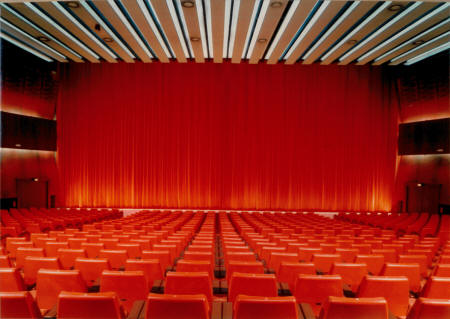 The Urgel cinema is a beautiful anachronism in today’s exhibition landscape.
In an era when cinema is mostly seen in shopping malls, this beautiful and
huge cinema is a good reminder of what going to the pictures used to be.
Today’s multiplexes pale in comparison but people who have grown used to
seeing films in small monitors would not know better. The Urgel cinema is a beautiful anachronism in today’s exhibition landscape.
In an era when cinema is mostly seen in shopping malls, this beautiful and
huge cinema is a good reminder of what going to the pictures used to be.
Today’s multiplexes pale in comparison but people who have grown used to
seeing films in small monitors would not know better.I hope that the cinema will remain open. Recently and thanks to the initiative of a Spanish film director, Nacho Cerdá, double bills with films from the 70s, 80s and 90s are shown at least once per month and the event has been a huge success. Let’s hope that they again show 70mm prints, especially the new restored prints. With many thanks to Mr Pedro Balañá for all the information and pictures provided With thanks also to Mr Gerard Muñoz Pleguezuelo for his pictures The Urgel Cinema - Gallery mainly 70mm releases, which illustrate this cinema’s history | |
| Go: back - top - back issues - news index Updated 22-01-25 |
